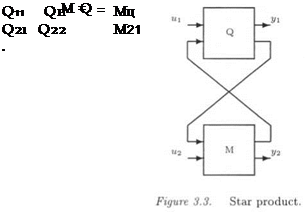THE GENERAL CASE
3.1 INTERCONNECTION OF LFTS • It is first illustrated that the interconnection of various elementary LFTs is also an LFT. Consider the example of Figure 3.2, which represents the way a complete LFT model of the transport aircraft will be obtained in the next chapter. Remember that a complete aircraft model is obtained by adding at the physical outputs the rigid and flexible models (see chapter 2).
An LFT model was separately obtained for both rigid and flexible models. This means that the rigid LFT model contains the physical inputs й and outputs yr and additional inputs wi and outputs z%, with the fictitious feedback wi = AZ (see Figure 3.2). In the same way, the flexible LFT model contains the physical inputs и and outputs у/ and additional inputs W2 and outputs Z2, with the fictitious feedback W2 = Д2^2- The complete LFT model of the aircraft, у = Fi(H(s),A)u, is computed as an interconnection of the two above LFTs. The augmented model perturbation is Д = diag(Aі, Д2), while H(s) is the transfer matrix between inputs u, w, W2 and outputs y, и i and Z2-
ir*
Figure 3.2. The interconnection of LFTs is an LFT
• The star product S(Q, M) of Q and M is defined in Figure 3.3 as a specific interconnection of two LFTs. It corresponds to the transfer
between inputs и і, и 2 and outputs уі, уї-
 Ft(Q, Mn) Qu{I – M11Q22) 1-^12}o1q
Ft(Q, Mn) Qu{I – M11Q22) 1-^12}o1q
 |
m21(i-q22mu)-1Q2i fu(











